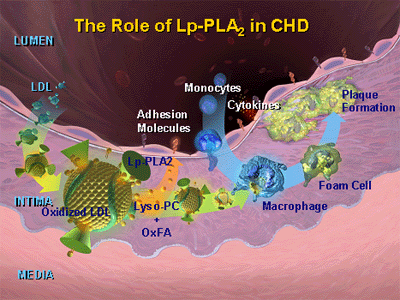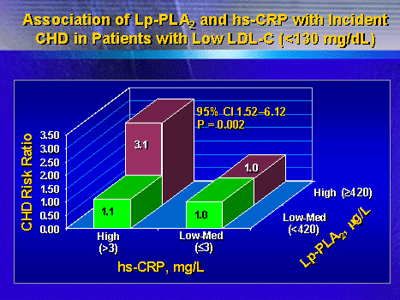Lipoprotein-associated
phospoholipase A2 (Lp-PLA2) and high-sensitivity
C-reactive protein (hs-CRP) are independently predictive of
coronary heart disease (CHD). In addition, people with normal
levels of LDL cholesterol may be at risk for a CHD event if
they have high levels of Lp-PLA2 or hs-CRP. These
data provide additional evidence that Lp-PLA2 is
a predictor of coronary events.
Approximately half of all patients who experience coronary
events such as myocardial infarction do not exhibit traditional
risk factors such as obesity, high blood pressure or elevated
LDL cholesterol. Thus, there is great interest in developing
other ways of identifying elevated CHD risk in apparently
healthy individuals. These individuals may benefit from statin
therapy.
Recently, some have recommended measuring hs-CRP to identify
patients at high risk of CHD despite low LDL cholesterol.
Some researchers believe Lp-PLA2 may be another
useful biomarker for identifying individuals at risk of CHD
despite normal cholesterol. Previously, investigators described
Lp-PLA2 as a novel risk factor for cardiac events.
In one major trial, patients who had the highest Lp-PLA2
had a risk for a coronary event nearly twice as high as patients
who had the lowest levels of this enzyme.
Dr. Ballantyne described the role of Lp-PLA2
in CHD. In the intima, Lp-PLA2 hydrolyzes oxidized
LDL to generate lysophosphatidylcholine and oxidized fatty
acid. These pro-inflammatory mediators cause up-regulation
of adhesion molecules and cytokine production, leading to
recruitment of monocytes from the lumen. Monocytes differntiate
into activated macrophages, which engulf oxidized LDL. The
resulting cells aggregate to form atheroscreotic plaque, which
produces cytokines that degrade smooth muscle cells and the
fibrous cap.

The purpose of this study was to evaluate the relationship
between Lp-PLA2, hs-CRP, traditional risk factors,
and the incidence of CHD events over 6 years. The prospective,
case-cohort study involved the patient population from the
Atherosclerosis Risk in Communities (ARIC) Study. This ongoing
study includes 12,819 apparently healthy middle aged individuals
in the United States. Investigators identified 609 participants
in ARIC who experienced CHD, and randomly selected 741 controls
from the population.
Investigators used a specific assay to determine serum levels
of Lp-PLA2, an enzyme found in plasma and arterial
plaques. The biotechnology company diaDexus manufactured and
supplied the assay.
As expected, the 609 patients who experienced a CHD event
had significantly higher LDL cholesterol, triglycerides and
total cholesterol than in controls. They had lower HDL cholesterol
and higher blood pressure than controls. In addition, they
had increased levels of hs-CRP and Lp-PLA2.
As investigators showed in previous studies, levels of Lp-PLA2
correlated positively with LDL cholesterol and negatively
with HDL cholesterol. There was no correlation with blood
pressure or levels of hs-CRP.
The highest risk of CHD, associated for age, sex and race,
occurred in the tertile of study subjects with the highest
Lp-PLA2 (relative risk of 1.16, versus 1.02 for
the middle tertile). For only the subjects with LDL cholesterol
under 130 mg/dL, risk adjusted for a variety of other risk
factors was also significant (2.02 in the upper tertile versus
1.81 in the middle tertile). When investigators adjusted for
hs-CRP, there was no change in the model, suggesting the two
factors are independent.
Clinicians might use Lp-PLA2 and hs-CRP together
to stratify individuals for CHD risk. Dr. Ballantyne's analysis
shows that individuals who had high hs-CRP and high Lp-PLA2
had the highest risk ratio.

These results indicate a possible target population for
statin therapy. Dr. Ballantyne noted that in the Heart Protection
Study, statin therapy reduced CHD risk even in patients with
normal levels of LDL cholesterol. Also, investigators in the
Anglo-Scandinavian
Cardiac Outcomes Trial (ASCOT) showed a similar result
here at ACC. While the findings regarding Lp-PLA2
and hs-CRP are promising, Dr. Ballantyne noted that expert
panels would probably require further corroboration before
they would enact a change in guidelines.
|